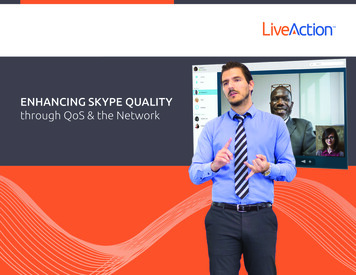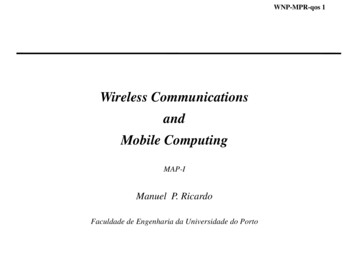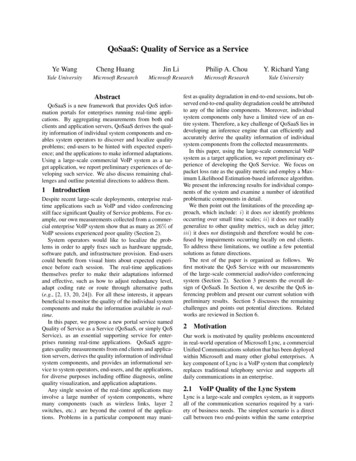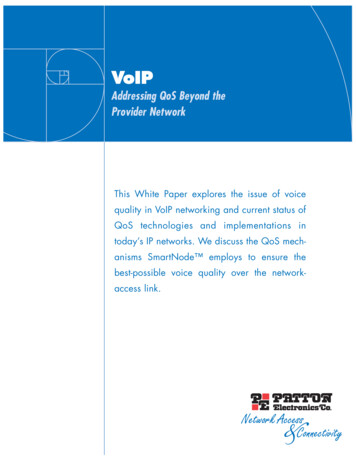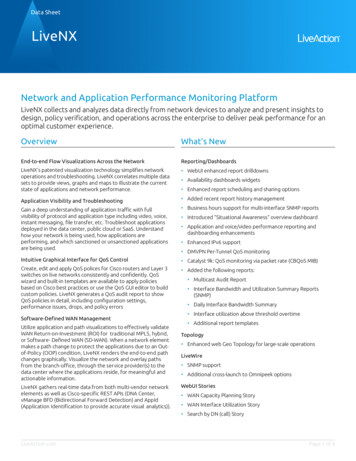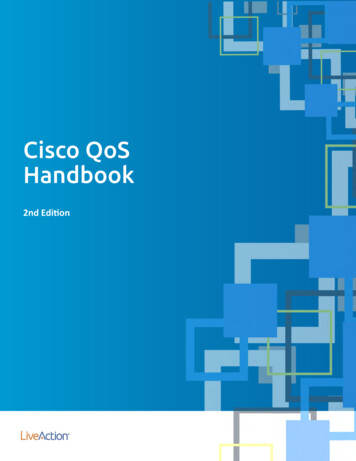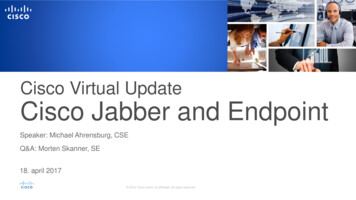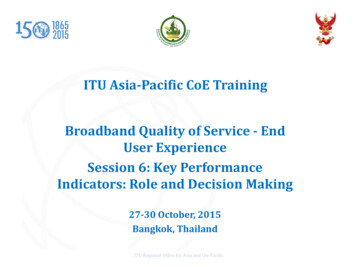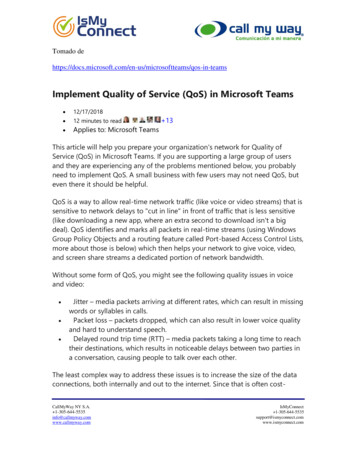
Transcription
Tomado qos-in-teamsImplement Quality of Service (QoS) in Microsoft Teams 12/17/2018 12 minutes to read Applies to: Microsoft Teams 13This article will help you prepare your organization's network for Quality ofService (QoS) in Microsoft Teams. If you are supporting a large group of usersand they are experiencing any of the problems mentioned below, you probablyneed to implement QoS. A small business with few users may not need QoS, buteven there it should be helpful.QoS is a way to allow real-time network traffic (like voice or video streams) that issensitive to network delays to "cut in line" in front of traffic that is less sensitive(like downloading a new app, where an extra second to download isn't a bigdeal). QoS identifies and marks all packets in real-time streams (using WindowsGroup Policy Objects and a routing feature called Port-based Access Control Lists,more about those is below) which then helps your network to give voice, video,and screen share streams a dedicated portion of network bandwidth.Without some form of QoS, you might see the following quality issues in voiceand video: Jitter – media packets arriving at different rates, which can result in missingwords or syllables in calls.Packet loss – packets dropped, which can also result in lower voice qualityand hard to understand speech.Delayed round trip time (RTT) – media packets taking a long time to reachtheir destinations, which results in noticeable delays between two parties ina conversation, causing people to talk over each other.The least complex way to address these issues is to increase the size of the dataconnections, both internally and out to the internet. Since that is often costCallMyWay NY S.A. sMyConnect ct.com
prohibitive, QoS provides a way to more effectively manage the resources youhave instead of adding new resources. To fully address quality issues you woulduse QoS across the implementation, then add connectivity only where absolutelynecessary.For QoS to be effective, you will have have consistent QoS settings applied endto end in your organization, because any part of the path that fails to supportyour QoS priorities can degrade the quality of calls, video, and screen shares. Thisincludes applying settings to all user PCs or devices, network switches, routers tothe internet, and the Teams online service.Figure 1. The relationship between an organization's networks and Office 365servicesIn most cases, the network connecting your enterprise to the cloud will be anunmanaged network where you won't be able to reliably set QoS options. Onechoice available to address end-to-end QoS is Azure ExpressRoute, but we stillrecommend that you implement QoS on your on-premises network for bothinbound and outbound traffic. This will increase the quality of real-timecommunication workloads throughout your deployment and alleviatechokepoints.Verify your network is readyIf you are considering a QoS implementation, you should already havedetermined your bandwidth requirements and other network requirements.CallMyWay NY S.A. sMyConnect ct.com
Traffic congestion across a network will greatly impact media quality. A lack ofbandwidth leads to performance degradation and a poor user experience. AsTeams adoption and usage grows, use reporting, Call Analytics, and Call QualityDashboard to identify problems and then make adjustments using QoS andselective bandwidth additions.VPN considerationsQoS only works as expected when implemented on all links between callers. Ifyou use QoS on an internal network and a user signs in from a remote location,you can only prioritize within your internal, managed network. Although remotelocations can receive a managed connection by implementing a virtual privatenetwork (VPN), a VPN inherently adds packet overhead and creates delays in realtime traffic. We recommend that you avoid running real-time communicationstraffic over a VPN.In a global organization with managed links that span continents, we stronglyrecommend QoS because bandwidth for those links is limited in comparison tothe LAN.Introduction to QoS queuesTo provide QoS, network devices must have a way to classify traffic and must beable to distinguish voice or video from other network traffic.When network traffic enters a router, the traffic is placed into a queue. If a QoSpolicy isn't configured, there is only one queue, and all data is treated as first-in,first-out with the same priority. That means voice traffic (which is very sensitive todelays) might get stuck behind traffic where a delay of a few extra millisecondswouldn't be a problem.When you implement QoS, you define multiple queues using one of severalcongestion management features (such as Cisco’s priority queuing and ClassBased Weighted Fair Queueing CBWFQ) and congestion avoidance features (suchas weighted random early detection WRED).Figure 2. Examples of QoS queuesCallMyWay NY S.A. sMyConnect ct.com
A simple analogy is that QoS creates virtual “carpool lanes” in your data networkso some types of data never or rarely encounter a delay. Once you create thoselanes, you can adjust their relative size and much more effectively manage theconnection bandwidth you have, while still delivering business-grade experiencesfor your organization's users.Select a QoS implementation methodYou could implement QoS via port-based tagging, using Access Control Lists(ACLs) on your network's routers. Port-based tagging is the most reliable methodbecause it works in mixed Windows and Mac environments and is the easiest toimplement. Mobile clients don’t provide a mechanism to mark traffic by usingDSCP values, so they will require this method.Using this method, your network's router examines an incoming packet, and ifthe packet arrived using a certain port or range of ports, it identifies it as a certainmedia type and puts it in the queue for that type, adding apredetermined DSCP mark to the IP Packet header so other devices canrecognize its traffic type and give it priority in their queue.Although this works across platforms, it only marks traffic at the WAN edge (notall the way to the client machine) and creates management overhead. You shouldrefer to the documentation provided by the router manufacturer for instructionson implementing this method.CallMyWay NY S.A. sMyConnect ct.com
You could also implement QoS implemented by using a Group Policy Object(GPO) to direct client devices to insert a DSCP marker in IP packet headersidentifying it as particular type of traffic(for example, voice). Routers and othernetwork devices can be configured to recognize this and put the traffic in aseparate, higher-priority queue.Although this scenario is entirely valid, it will only work for domain-joinedWindows clients. Any device that isn’t a domain-joined Windows client won’t beenabled for DSCP tagging. Clients such as Mac OS have hard-coded tags and willalways tag traffic.On the plus side, controlling the DSCP marking via GPO ensures that all domainjoined computers receive the same settings and that only an administrator canmanage them. Clients that can use GPO will be tagged on the originating device,and then configured network devices can recognize the real-time stream by theDSCP code and give it an appropriate priority.We recommend a combination of DSCP markings at the endpoint and portbased ACLs on routers, if possible. Using a Group Policy object to catch themajority of clients, and also using port-based DSCP tagging will ensure thatmobile, Mac, and other clients will still get QoS treatment (at least partially).DSCP markings can be likened to postage stamps that indicate to postal workershow urgent the delivery is and how best to sort it for speedy delivery. Onceyou've configured your network to give priority to real-time media streams, lostpackets and late packets should diminish greatly.Once all devices in the network are using the same classifications, markings, andpriorities, it’s possible to reduce or eliminate delays, dropped packets, and jitterby changing the size of the port ranges assigned to the queues used for eachtraffic type. From the Teams perspective, the most important configuration step isthe classification and marking of packets, but for end-to-end QoS to besuccessful you also need to carefully align the application’s configuration with theunderlying network configuration. Once QoS is fully implemented, ongoingmanagement is a question of adjusting the port ranges assigned to each traffictype based on your organization's needs and actual usage.CallMyWay NY S.A. sMyConnect ct.com
Choose initial port ranges for each media typeThe DSCP value tells a correspondingly configured network what priority to give apacket or stream, whether the DSCP mark is assigned by clients or the networkitself based on ACL settings. Each media workload gets its own unique DSCPvalue (other services might allow workloads to share a DSCP marking, Teamsdoes not) and a defined and separate port range used for each media type. Otherenvironments might have an existing QoS strategy in place, which will help youdetermine the priority of network workloads.The relative size of the port ranges for different real-time streaming workloadssets the proportion of the total available bandwidth dedicated to that workload.To return to our earlier postal analogy: a letter with an "Air Mail" stamp might gettaken within an hour to the nearest airport, while a small package marked "BulkMail" mark can wait for a day before traveling over land on a series of trucks.The following table shows the required DSCP markings and the suggestedcorresponding media port ranges used by both Teams and ExpressRoute. Theseranges might serve as a good starting point for customers who are unsure whatto use in their own environments. To learn more, read ExpressRoute QoSrequirements.Recommended initial port rangesBe aware of the following when you use these settings: If you plan to implement ExpressRoute in the future and haven’t yetimplemented QoS, we recommend that you follow the guidance so thatDSCP values are the same from sender to receiver.All clients, including mobile clients and Teams devices, will use these portranges and will be affected by any DSCP policy you implement that usesthese source port ranges. The only clients that will continue to use dynamicCallMyWay NY S.A. sMyConnect ct.com
ports are the browser-based clients (that is, those clients that letparticipants join meetings by using their browsers).Although the Mac client uses the same port ranges, it also uses hardcoded values for audio (EF) and video (AF41). These values are notconfigurable.If you later need to adjust the port ranges to improve user experience, theport ranges can not overlap and should be adjacent to each other.Migrate QoS to TeamsIf you’ve previously deployed Skype for Business Online, including QoS taggingand port ranges, and are now deploying Teams, Teams will respect the existingconfiguration and will use the same port ranges and tagging as the Skype forBusiness client. In most cases, no additional configuration will be needed.QoS implementation stepsAt a very high level, implementing QoS requires these steps:1.2.3.4.Verify your network is readySelect a QoS implementation methodChoose initial port ranges for each media typeImplement QoS settings:a. On Clients using a GPO to set client device port ranges andmarkingsb. On routers (see the manufacturer documentation) or other networkdevices. This may include port-based ACLs or simply defining theQoS queues and DSCP markings, or all of these.CallMyWay NY S.A. sMyConnect ct.com
c. On Teams Admin Center5.Validate the QoS implementation by analyzing Teams traffic on thenetwork.As you prepare to implement QoS, keep the following guidelines in mind:The shortest path to Office 365 is best. Closing ports will only lead to quality degradation. Any obstacles in-between, such as proxies, are not recommended. Limit the number of hops:oClient to network edge – 3 to 5 hops.oISP to Microsoft network edge – 3 hopsoMicrosoft network edge to final destination – irrelevant For information about configuring firewall ports, go to Office 365 URLs and IPranges.Managing source ports in the Teams admin centerIn Teams, QoS source ports used by the different workloads should be activelymanaged, and adjusted as necessary. Referring to the table in Choose initial portranges for each media type, the port ranges are adjustable, but the DSCPmarkings are not configurable. Once you have implemented these settings, youmay find that more or fewer ports are needed for a given media type. CallAnalytics and Call Quality Dashboard should be used in making a decision toadjust port ranges after Teams has been implemented, and periodically as needschange.CallMyWay NY S.A. sMyConnect ct.com
If you’ve previously deployed Skype for Business Server on-premises, you mayneed to re-examine your QoS policies and adjust them as needed to match portrange settings you've verified provide a quality user experience for Teams.Validate the QoS implementationFor QoS to be effective, the DSCP value set by the Group Policy object needs tobe present at both ends of a call. By analyzing the traffic generated by the Teamsclient, you can verify that the DSCP value isn’t changed or stripped out when theTeams workload traffic traverses moves through the network.Preferably, you capture traffic at the network egress point. You can use portmirroring on a switch or router to help with this.Use Network Monitor to verify DSCP valuesNetwork Monitor is a tool you can download from Microsoft to analyze networktraffic.1.On the PC running Network Monitor, connect to the port that has beenconfigured for port mirroring and start capturing packets.2. Make a call by using the Teams client. Make sure media has beenestablished before hanging up the call.3. Stop the capture.4. In the Display Filter field, use the source IP address of the PC that madethe call, and refine the filter by defining DSCP value 46 (hex 0x2E) as searchcriteria, as shown in the following example:Source "192.168.137.201" AND IPv4.DifferentiatedServicesField 0x2E5.6.7.Select Apply to activate the filter.In the Frame Summary window, select the first UDP packet.In the Frame Details window, expand the IPv4 list item and note the valueat the end of the line that begins with DSCP.CallMyWay NY S.A. sMyConnect ct.com
In this example, the DSCP value is set to 46. This is correct, because the sourceport used is 50019, which indicates that this is a voice workload.Repeat the verification for each workload that has been marked by the GPO.More informationVideo: Network PlanningPrepare your organization's network for Microsoft TeamsExpressRoute QoS requirementsCallMyWay NY S.A. sMyConnect ct.com
traffic over a VPN. In a global organization with managed links that span continents, we strongly recommend QoS because bandwidth for those links is limited in comparison to the LAN. Introduction to QoS queues To provide QoS, network devices must have a way to classify traffic and must be able to distinguish voice or video from other network .
